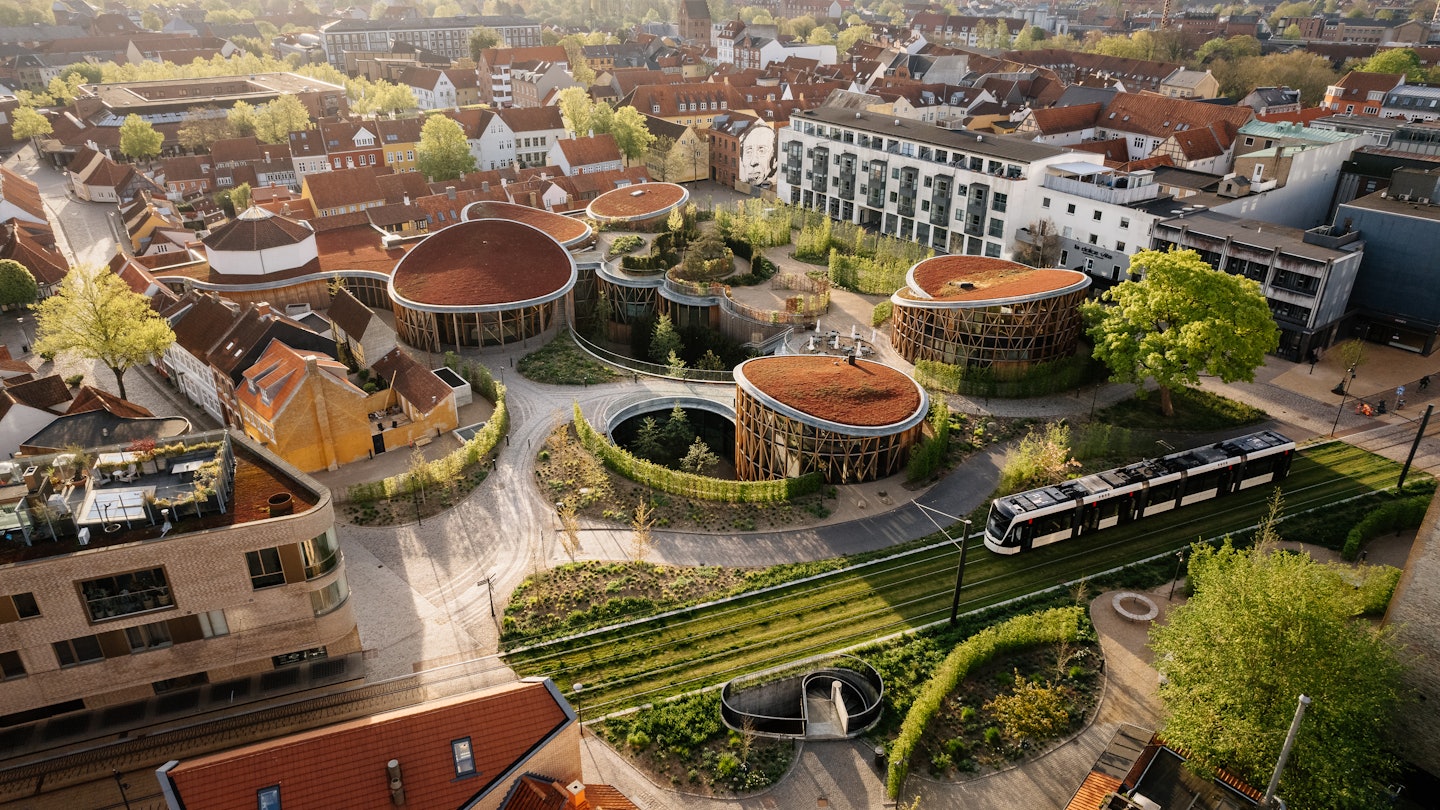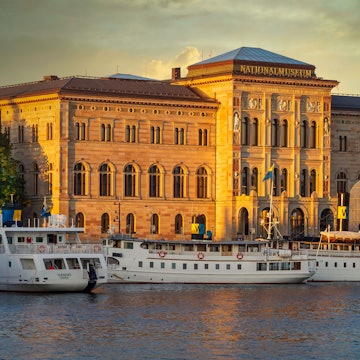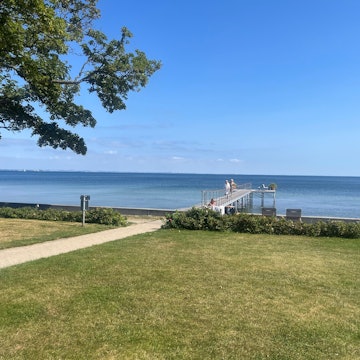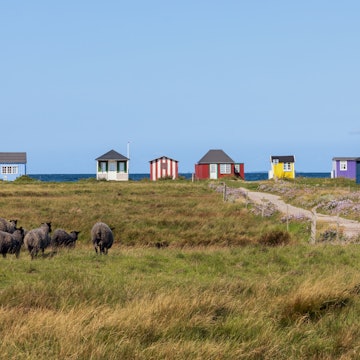
The 8 best day trips from Copenhagen


Odense, Denmark. ThomasMorkeberg/Getty Images
The culturally rich city of Copenhagen has plenty of activities to keep visitors busy for many days, but it’s also ideally situated for day trips to a variety of other interesting and scenic destinations in Denmark and beyond. Think knitted wool sweaters, colorful snow-topped houses and warm hygge vibes.
Travelers interested in adventures further afield will find impressive castles, historic cathedrals, top-notch museums, captivating cities and quaint villages, all within easy reach by public transport in 90 minutes or less.
Learn about Denmark's history of kings and Vikings, explore its lovely landscapes and discover a world apart from its cosmopolitan capital with these top day trips from Copenhagen.

1. Tour Frederiksborg Slot in Hillerød
Travel time: 45–55 minutes
How to travel: By train and bus
In the early 17th century, Denmark's legendary King Christian IV took the original castle in Hillerød and transformed it into a magnificent Renaissance-style royal residence. His creation, the fairy-tale Frederiksborg Slot – often called the Nordic Versailles – became the Danish National History Museum in 1878.
The castle sits beside a lake and features lovely Baroque gardens, while its interior is both historically fascinating and lavishly appointed – the ballroom and the chapel are exceptionally breathtaking. During summer weekends, guided tours of the castle take place at 11:30am, and there is a special children's exhibit for young visitors.
How to get to Hillerød from Copenhagen:
Take S-train line A to Hillerød. The journey takes approximately 40 minutes. Frederiksborg Castle is a 15-minute walk from Hillerød station. If that's too long a walk, buses 301 or 302 will take you to the castle from outside the station in about 5 minutes.

2. See Viking ships and Denmark’s royal burial church in Roskilde
Travel time: 30–40 minutes
How to travel: By train and foot
Located on a long, narrow fjord west of Copenhagen, Roskilde is one of Denmark’s oldest cities. A former capital of Denmark and seat of the monarchy, it began as a thriving Viking town and now has a wealth of history to be explored.
At the Viking Ship Museum, five ships pulled from the bottom of the Roskilde Fjord 1000 years after they were deliberately sunk have been painstakingly reassembled and displayed. Using original materials and techniques, they have also been recreated to scale as sea-going vessels. There are outdoor shipbuilding, rope-making and blacksmithing exhibits, as well as a cafe serving delicious Viking-inspired food.
Roskilde Cathedral was built in 1275 and is the resting place of 38 Danish kings and queens. The stunning Gothic church features a soaring nave and several chapels with ornate sarcophagi of the monarchs.
How to get to Roskilde from Copenhagen:
The town is 20 to 30 minutes by train west of Copenhagen Central Station. The cathedral is approximately a 10-minute walk from the station, while it takes around 20 minutes to reach the Viking Ship Museum.

3. Fill your lungs with Nordic forest air in Dyrehaven
Travel time: 20 minutes
How to travel: By train
Just 20 minutes by train from bustling central Copenhagen lies UNESCO World Heritage-listed Dyrehaven, a vast nature reserve with a verdant forest, sweeping fields and an extensive network of trails. It's open year-round and is an ideal spot for a walk, bike ride or picnic.
Once a royal hunting ground, the park is home to hundreds of wild deer, which visitors easily and often spot. In the summer months, it's possible to take a tour of the Hermitage, a former royal hunting lodge. Within Dyrehaven is Bakken, the world's oldest amusement park, which is free to enter and features both family-friendly and thrilling rides, as well as restaurants and shows.
How to get to Dyrehaven from Copenhagen:
Take a 20-minute S-train line C to Klampenborg. Dyrehaven lies just outside the station, and Bakken is approximately a 10-minute walk inside the park.

4. Step back in time in Dragør
Travel time: 45 minutes
How to travel: By bus
Experience small-town Denmark in the charming medieval fishing village Dragør, founded in the 12th century. Get lost in the maze of the tiny cobblestone streets lined with pale yellow, centuries-old homes, some still thatched in the ancient style. Stroll along the harbor, stop by local shops and galleries, grab a bite to eat at one of the cafes and simply enjoy the small-town feel. In the summer months, Dragør hosts a variety of markets and festivals. In winter, try ice skating or cozy up in a sauna.
How to get to Dragør from Copenhagen:
Take bus 250S from Copenhagen Central Station (about 45 minutes).

5. Immerse yourself in modern art in Humlebæk
Travel time: 36–40 minutes
How to travel: By train and bus
Set in a verdant park overlooking the Øresund strait, the Louisiana Museum of Modern Art houses one of Scandinavia’s most extensive collections of modern art – over 4,000 individual pieces in various mediums, particularly painting and sculpture. Due to the size of the collection, exhibits change regularly. Nearly 48 sculptures are scattered throughout the park’s varied terrain, which includes woodlands, lawns, a terrace and a gorge sloping down to a beach. Even if you’re not a modern art connoisseur, the lovely setting and harmony between art and nature make the Louisiana worth a visit. The museum cafe is a good spot for a coffee break or a full meal.
How to get to Humlebæk from Copenhagen:
It’s just over 30 minutes by train from Copenhagen to Humlebæk Station, and then about a 10-minute walk (or a 6-minute bus ride) to Louisiana.

6. Visit the castle that inspired Shakespeare's Hamlet in Helsingør
Travel time: 60 minutes
How to travel: By train and foot
The charming seaside town of Helsingør sits on Denmark's northeastern coast. Adjacent to the historic homes, local shops and cafes is the town's centerpiece, Kronborg Castle, the inspiration for Elsinore in William Shakespeare's Hamlet. King Frederik II transformed a military stronghold into a stunning Renaissance castle in the 1500s to collect dues from passing ships and demonstrate his wealth and power. It was the opulence of the castle and lavish feasts held here that inspired the Bard.
Today, visitors can tour the royal apartments, admire the king's tapestries and explore the eerie casemates under the castle. Between June and August, costumed actors roam the castle in character, performing scenes from Hamlet. In December, Kronborg hosts a cozy Christmas market. Helsingør town is a lovely place to dine, and the cathedrals of Sankt Mariæ and Sankt Olai are beautiful and free to enter. There is also a ferry to Sweden: the town of Helsingborg is only 20 minutes away by boat.
How to get to Helsingør from Copenhagen:
The regional train frequently runs from Copenhagen Central Station to Helsingør. The journey takes approximately 45 minutes. Kronborg Castle is less than a 15-minute walk along the harbor from Helsingør station.

7. Walk in the footsteps of Hans Christian Andersen in Odense
Travel time: 70–95 minutes
How to travel: By train
A vibrant city with a lively dining scene, many parks and an excellent zoo, Odense is best known as the childhood home of fairytale author Hans Christian Andersen. Entrance to the house where he was born and raised in poverty is part of a combination ticket that also includes HC Andersens Hus, which further explores his life and legacy, as well as the TID – Museum for Odense, a museum about the history of Odense and Funen. Also worth a visit is the open-air museum Den Fynske Landby, an 1850s village of buildings transplanted from around the island.
How to get to Odense from Copenhagen:
The train from Copenhagen Central Station takes approximately 70–95 minutes, depending on the specific departure.

8. Cross the epic Øresund Bridge into Malmö, Sweden
Travel time: 40 minutes
How to travel: By train
It’s easy to go from Copenhagen to Malmö for a day excursion, although Sweden’s third-largest city is also an excellent choice for a weekend trip. The city combines old-world Dutch Renaissance buildings with modern architectural marvels. Middle Eastern markets, Italian coffee culture and edgy, gritty bars challenge Nordic stereotypes at every corner.
If you have just one day in Malmö, explore the historic heart of Gamla Staden first, a handsome warren of cobblestone streets, half-timbered houses and bold facades. Then head to the buzzing bayside Västra Hamnen to see the city's modern side. It's a popular spot to stroll, sip coffee and browse boutiques, but most people come to marvel at the Øresund Bridge and ogle the Turning Torso – one of Scandinavia’s tallest buildings – twisting its way skyward.
How to get to Malmö from Copenhagen:
It’s a 40-minute train ride from Copenhagen Central Station to Malmö Central on the Øresundståg, which departs every 20 minutes.













